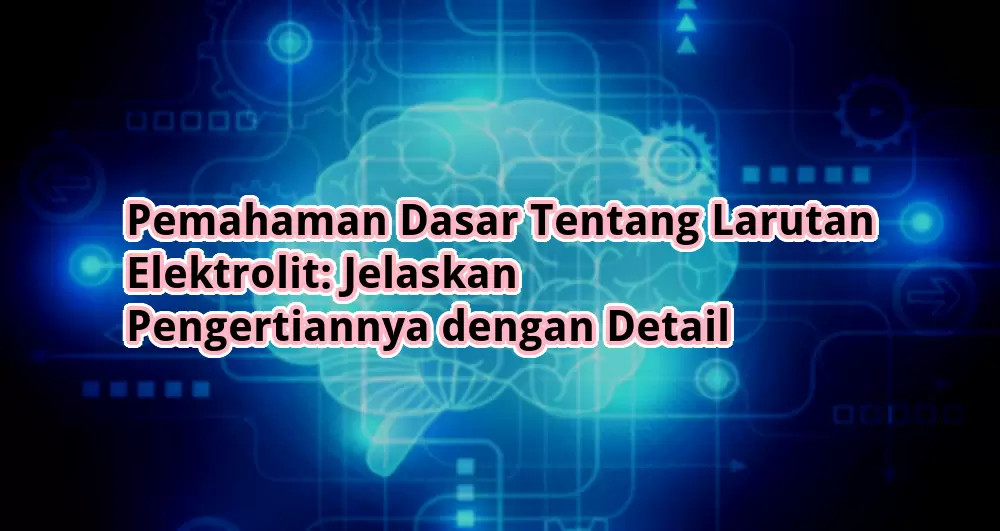
Jelaskan Pengertian Larutan Elektrolit: Exploring the World of Electrolyte Solutions
? Introduction
Hello zflas.co, welcome to this informative article on the topic of “Jelaskan Pengertian Larutan Elektrolit” or “Explaining the Definition of Electrolyte Solutions.” In this article, we will delve into the fascinating world of electrolyte solutions and understand their significance in various fields such as chemistry, biology, and industry. So, let’s embark on this educational journey together!
? What are Electrolyte Solutions?
Electrolyte solutions are aqueous solutions that contain ions, which are electrically charged particles. These solutions conduct electricity due to the movement of ions within them. When certain substances, known as electrolytes, dissolve in a solvent like water, they dissociate into positive and negative ions, enabling the flow of electric current.
? Understanding the Properties of Electrolyte Solutions
Electrolyte solutions possess unique characteristics that set them apart from non-electrolyte solutions. Let’s explore some of their key properties:
⚡ Strengths of Electrolyte Solutions
1. Facilitate Electrolysis: Electrolyte solutions play a vital role in various electrochemical processes, such as electrolysis. They allow for the separation of elements and compounds through the application of an electric current.
2. Conduct Electricity: Due to the presence of ions, electrolyte solutions have the ability to conduct electricity, making them essential in electrical circuits, batteries, and other electronic devices.
3. Enable Biological Processes: Electrolyte solutions are crucial for numerous biological processes, including nerve conduction, muscle contraction, and maintaining the pH balance in our bodies.
4. Enhance Chemical Reactions: In chemical reactions, electrolyte solutions can enhance the rate of reaction by providing a suitable medium for ions to interact and participate in different chemical processes.
5. Industrial Applications: Many industries rely on electrolyte solutions for various purposes like metal plating, electrorefining, and wastewater treatment, among others.
6. Quantitative Analysis: Electrolytic conductivity measurements in solutions are widely used in analytical chemistry to determine the concentration of ions, thus aiding in quantitative analysis.
7. Essential for Energy Storage: Electrolyte solutions are utilized in energy storage devices such as supercapacitors and fuel cells, contributing to the development of sustainable energy solutions.
⚡ Weaknesses of Electrolyte Solutions
1. Corrosion: Certain electrolyte solutions can cause corrosion of metals, which can lead to the deterioration of structures and equipment in various industries.
2. Environmental Impact: Improper disposal of electrolyte solutions can have detrimental effects on the environment, as some electrolytes are toxic and can contaminate water sources.
3. Limitations in Solubility: Some electrolytes have limited solubility in water, affecting their ability to conduct electricity effectively.
4. Cost: The production and acquisition of certain electrolytes can be expensive, especially for specialized applications or high-purity requirements.
5. Health Risks: Ingesting excessive amounts of certain electrolytes can disrupt the electrolyte balance in the body, leading to health issues such as dehydration or electrolyte imbalances.
6. Storage Challenges: Certain electrolyte solutions require specific storage conditions to maintain their stability and effectiveness, which can pose logistical challenges.
7. Sensitivity to Temperature: The conductivity of electrolyte solutions can be influenced by temperature changes, requiring careful control and monitoring in specific applications.
? Exploring the Definition of Electrolyte Solutions in Detail
| Term | Definition |
|---|---|
| Electrolyte | A substance that, when dissolved in a solvent, produces ions and enables the flow of electric current through the resulting solution. |
| Ions | Electrically charged particles formed when electrolytes dissociate in a solvent. They can be positively charged (cations) or negatively charged (anions). |
| Dissociation | The separation of an electrolyte into its constituent ions when dissolved in a solvent, primarily due to the solvent’s polarity. |
| Conductivity | The ability of a substance to conduct electric current. Electrolyte solutions have high conductivity due to the presence of ions. |
? Frequently Asked Questions (FAQs)
1. Apa itu larutan elektrolit?
Larutan elektrolit adalah larutan yang mengandung ion-ion bermuatan listrik dan dapat menghantarkan arus listrik.
2. Apa perbedaan antara larutan elektrolit dan non-elektrolit?
Larutan elektrolit mengandung ion-ion yang dapat menghantarkan arus listrik, sedangkan larutan non-elektrolit tidak mengandung ion-ion yang dapat menghantarkan arus listrik.
3. Bagaimana cara larutan elektrolit menghantarkan arus listrik?
Larutan elektrolit menghantarkan arus listrik melalui pergerakan ion-ion yang terdapat di dalamnya. Ion-ion tersebut bergerak karena adanya gaya listrik yang diberikan.
4. Apa contoh larutan elektrolit?
Contoh larutan elektrolit adalah larutan garam, larutan asam, dan larutan basa.
5. Apa yang menyebabkan larutan elektrolit dapat menghantarkan arus listrik?
Larutan elektrolit dapat menghantarkan arus listrik karena adanya ion-ion yang dapat berpindah tempat dalam larutan ketika dikenai medan listrik.
6. Apa yang membedakan larutan elektrolit kuat dan lemah?
Larutan elektrolit kuat dapat sepenuhnya terdisosiasi menjadi ion-ion di dalam larutan, sedangkan larutan elektrolit lemah hanya terdisosiasi sebagian.
7. Bagaimana pengaruh larutan elektrolit terhadap keseimbangan elektrolit dalam tubuh?
Penggunaan larutan elektrolit yang tidak tepat dapat mengganggu keseimbangan elektrolit dalam tubuh, yang dapat berdampak negatif pada fungsi organ dan sistem tubuh.
? Conclusion: Embrace the Power of Electrolyte Solutions
As we conclude our exploration of the definition of electrolyte solutions, we have witnessed their crucial role in various scientific, industrial, and biological applications. From facilitating electrical conductivity to enabling chemical reactions, these solutions have transformed numerous fields. It is essential to understand both their strengths and weaknesses to harness their potential while addressing their limitations responsibly.
So, whether you are a student, a researcher, or someone curious about the world around us, embrace the power of electrolyte solutions and continue to explore the intriguing realm of science and its practical applications.
? Disclaimer
The information provided in this article is for educational and informational purposes only. The content should not be considered as professional advice or a substitute for seeking expert guidance. The readers are solely responsible for any actions they take based on the information provided in this article.
